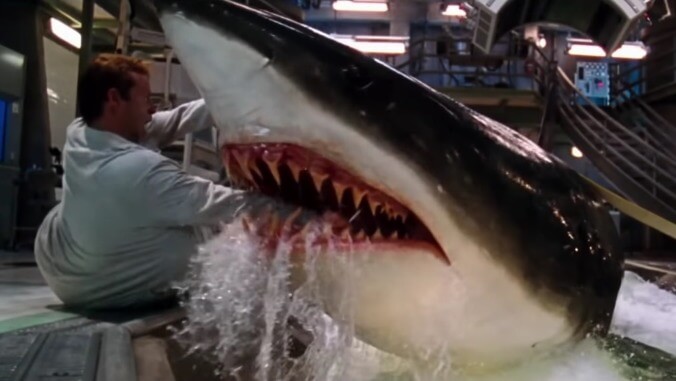Cap off Shark Week with a mathematical model of Stellan Skarsgård's Deep Blue Sea death scene

As always, the end of another year’s Shark Week is an opportunity to look back fondly on big toothy fish and the ridiculous ways in which our best-loved art and entertainment has run roughshod over natural science to make sharks seem even scarier than they already are.
No movie better fits this mold than 1999's Deep Blue Sea, a cinematic fever dream about an undersea laboratory that comes under attack by super-smart sharks whose brains have been messed with by a team of scientists. Though Samuel L. Jackson plays the character who gets the most memorable death, Movies, Films, & Flix’s Mark Hofmeyer makes a strong case that Stellan Skarsgård’s Dr. Jim Whitlock actually has the better end due to an “incredibly long death scene…that is equal parts terrifying, inventive, and funny.”
After mentioning how it all starts—Skarsgård getting his arm bitten off and prepared for evacuation—Hofmeyer gets into the spectacular conclusion of the attack, which sees the character’s medical gurney snapped up by a genius shark and “used as a battering ram” to break through a big underwater window into the lab. What’s most notable is that the entire thing, from the initial attack to the window-smashing, takes place over what seems like an extraordinarily long time.
Captivated by the mechanics of the scene, Hofmeyer gets into the nitty gritty of how it all worked. With the qualification that he’s analyzing “a fictitious moment in an insane film about genetically engineered sharks herding humans to their death” out of the way, Hofmeyer calculates how far Skarsgård, strapped to the gurney with an oxygen mask letting him breathe, spent being swum around by his fishy tormentor.
A true professional, Hofmeyer uses clues from the movie’s description of the underwater lab’s dimensions and external research on freight elevator and shark swimming speeds to map out the rest. He ends up determining that, by the time the movie’s “ridiculously fast” shark “got everything right and exploded to 60 MPH,” it’s likely that “the total estimated distance covered by Skarsgård is 5,959 feet or 1.12 miles.”
“That is impressive” he adds, unnecessarily.
Anyone interested in reading more (specifically architects designing future shark-proof research facilities) can check out Hofmeyer’s full article here. We can reasonably guarantee you won’t come across a more in-depth look into Stellan Skarsgård’s Deep Blue Sea death scene today.
Send Great Job, Internet tips to [email protected]